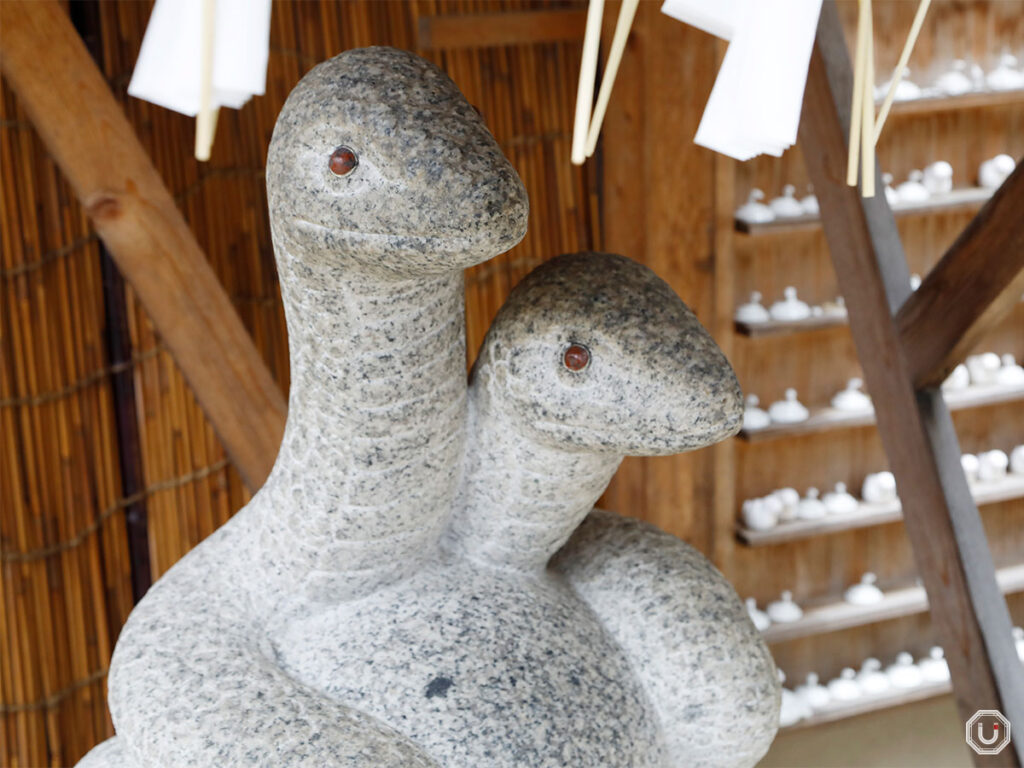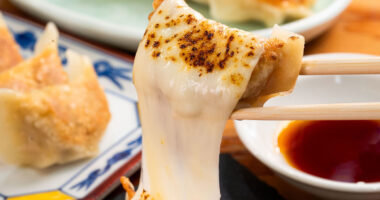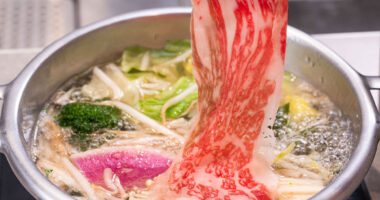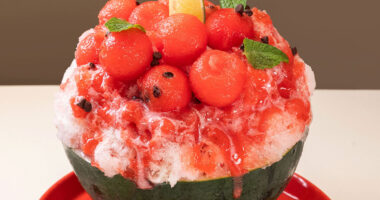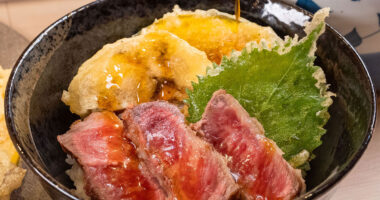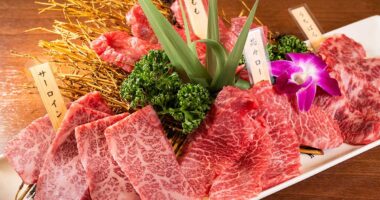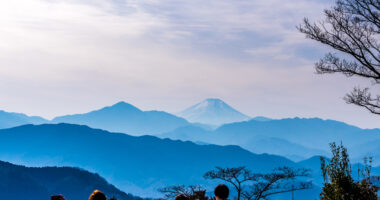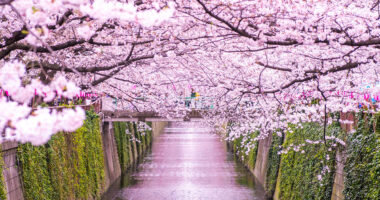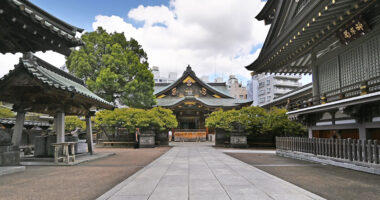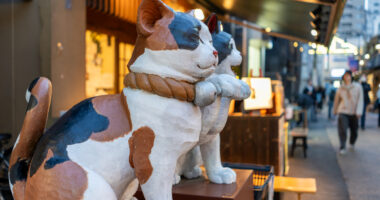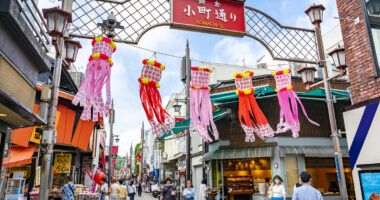Nestled in Tokyo’s Shinagawa Ward, Hebikubo Shrine is dedicated to the white snake, a revered creature believed to be a divine messenger.
The shrine sees a surge of visitors on the “Day of the Snake,” an auspicious occasion that takes place every 12 days and is considered especially lucky. To find out when the next Day of the Snake will be, it’s best to check the shrine’s website before planning your visit.
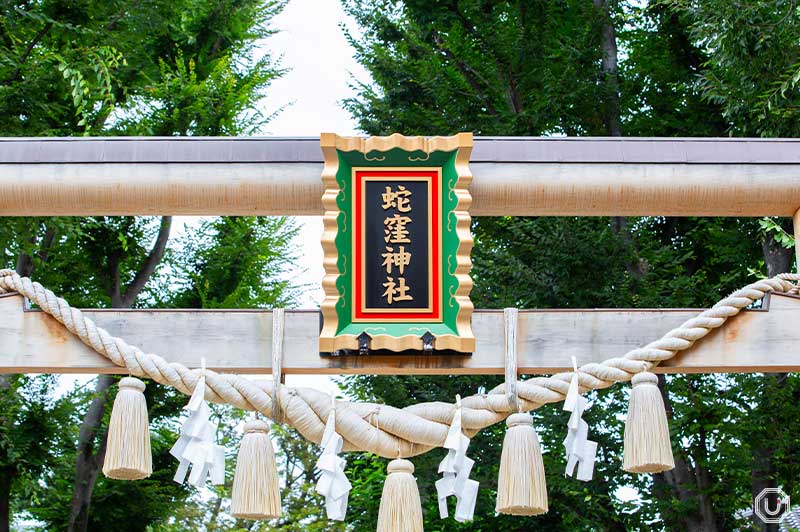
The connection between Hebikubo Shrine and the white snake dates back to Japan’s Kamakura period (late 12th to early 14th century).
During this time, the shrine had a washing area where a white snake made its home. However, as the washing area eventually disappeared, the snake lost its dwelling. One night, it appeared in the dream of a local leader, pleading to have its home restored.
In response, a pond was dug, and the Shirohebi Benzaiten Shrine was built to welcome the white snake, marking the beginning of its worship at the site.
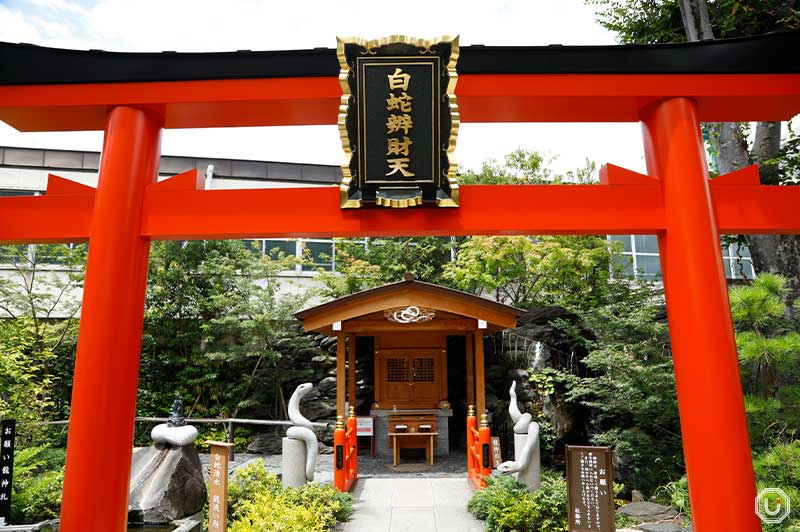
Shirohebi Benzaiten Shrine
A scenic route to the worship hall with seasonal flowers and other highlights
Before entering the shrine grounds, bow once before crossing the torii gate, then proceed to the purification water basin called temizuya or chōzuya (meaning “hand water station”) to cleanse your hands.
The temizuya is beautifully adorned with floating seasonal flowers, creating a serene and picturesque scene. The flowers are changed regularly, especially on the Day of the Snake, allowing visitors to experience a different atmosphere throughout the year.
The tranquil scenery makes you want to linger and unwind, offering a perfect moment of relaxation.
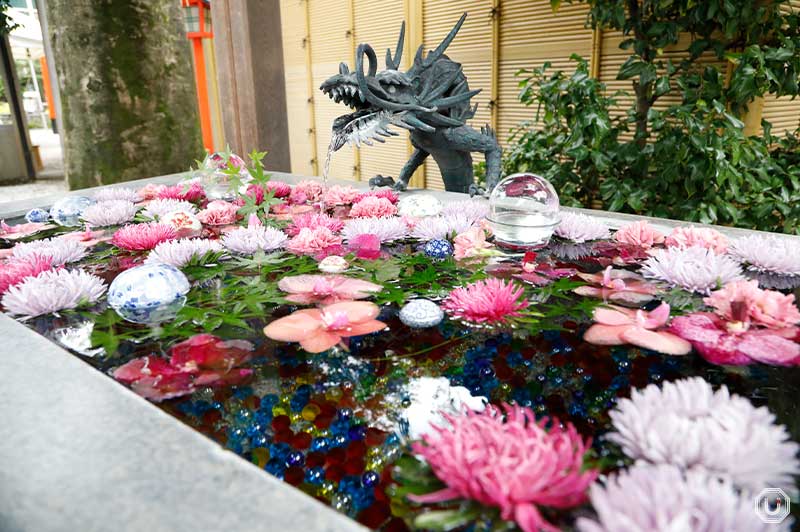
Temizuya
As you make your way toward the main shrine, you’ll pass the Hebikubo Ryūjin Shrine on your right, one of several shrines within the Hebikubo Shrine grounds.
Before visiting Hebikubo Ryujin Shrine, be sure to stop at the “Nade Shirohebi” (meaning “white snakes for stroking”), stone statues representing a pair of white snakes, with the larger one symbolizing the wife and the smaller one representing the husband.
Inspired by the symbolism of the snake, an animal which regularly sheds its skin, the statue is believed to grant blessings of self-renewal and revitalization.
To pay your respects, gently stroke the statues while making your wishes.
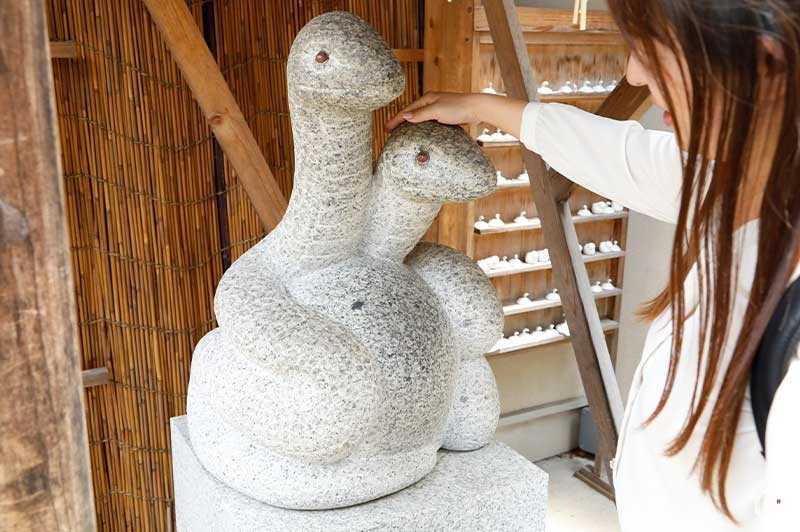
The Nade Shirohebi statue
Next, continue to the Hebikubo Ryujin Shrine, which enshrines the guardian deity. The golden torii gate here might give you a feeling that your financial luck is about to improve.
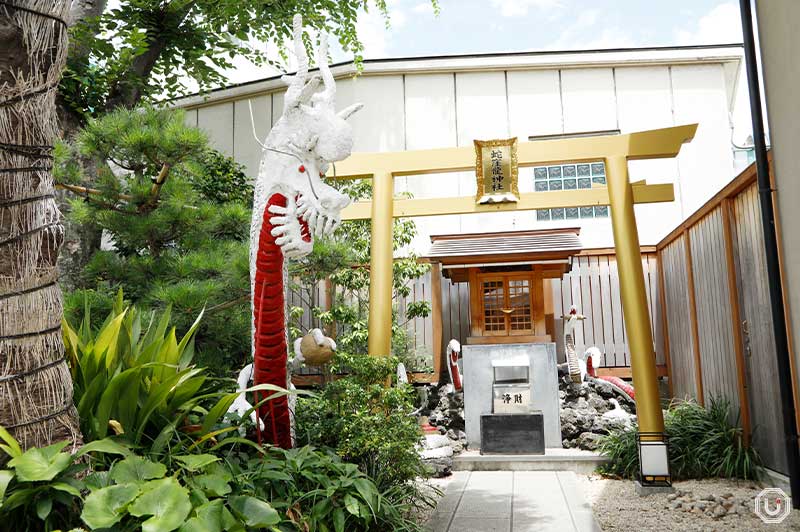
Hebikubo Ryujin Shrine
Surrounding the Hebikubo Ryujin Shrine are a striking eight-meter-long white dragon and seven white snakes. The guardian deity is believed to have protected the shrine for over 1,000 years.
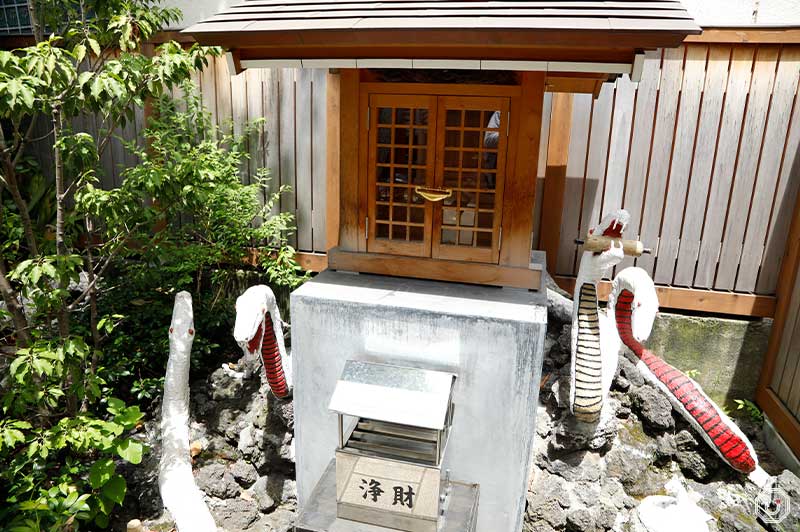
After making your offering, pray to the guardian deity using the following protocol: Bow twice, bending your body 90 degrees, clap twice, and finish with a deep bow.
For a more respectful gesture, your right hand should be slightly lower than your left—around the height of the last finger joint—when clapping.
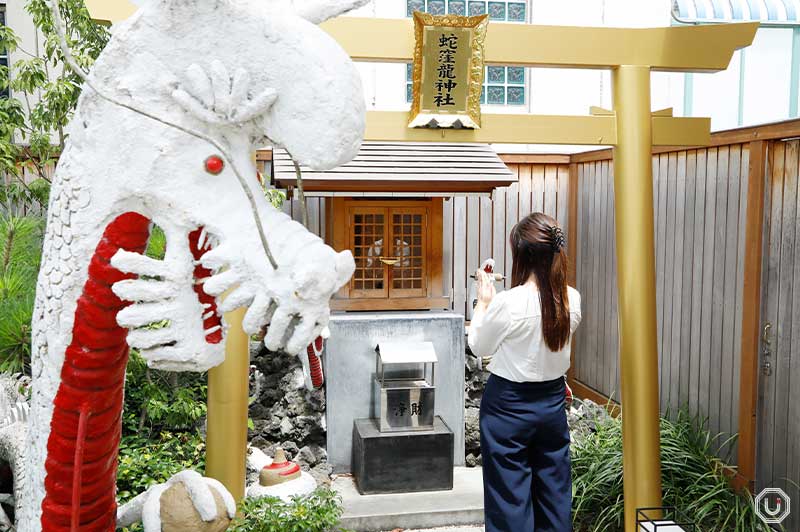
After paying your respects, head to two spots believed to enhance your financial luck.
Start with the spot for “Zeni-Mawashi” (literally “making money go around”). After making an offering, take a coin called the Shirohebi tanesen (meaning “seed money”), provided by the shrine, and place it on the stone mill.
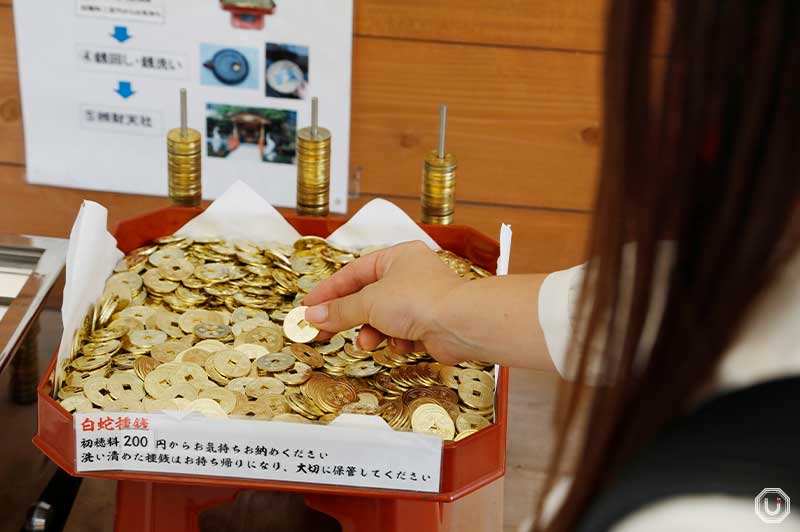
Collect a Shirohebi tanesen after making an offering (from 200 JPY)
The rule is to turn the stone mill three times to the right, in the hopes that money, just like society, will go around to the benefit of all. In so doing, you purify the coin.
Hold on to your purified Shirohebi tanesen, as you’ll need it at the next stop, the zeniaraijo (money-washing place).
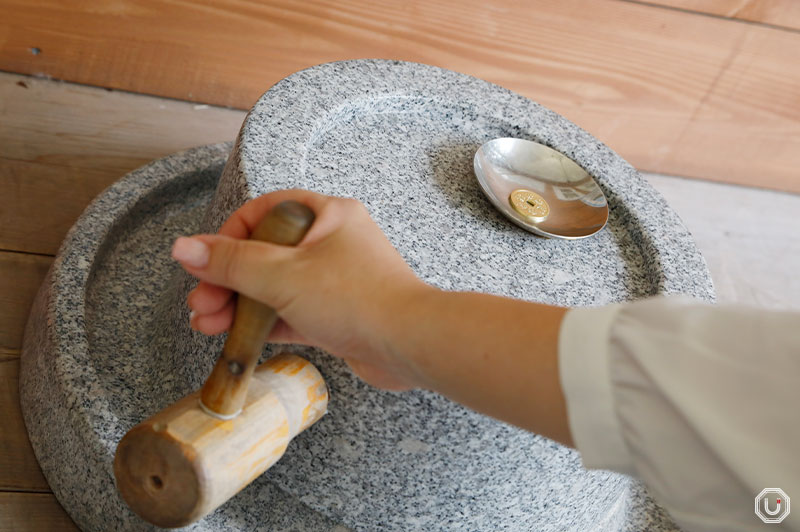
Zeni-Mawashi
At the zeniaraijo, place your Shirohebi tanesen and your own money into the provided basket and gently submerge it in water.
It’s important to take your time and avoid rushing. Once they’re thoroughly purified, carry the Shirohebi tanesen and your money together to the Shirohebi Benzaiten Shrine.
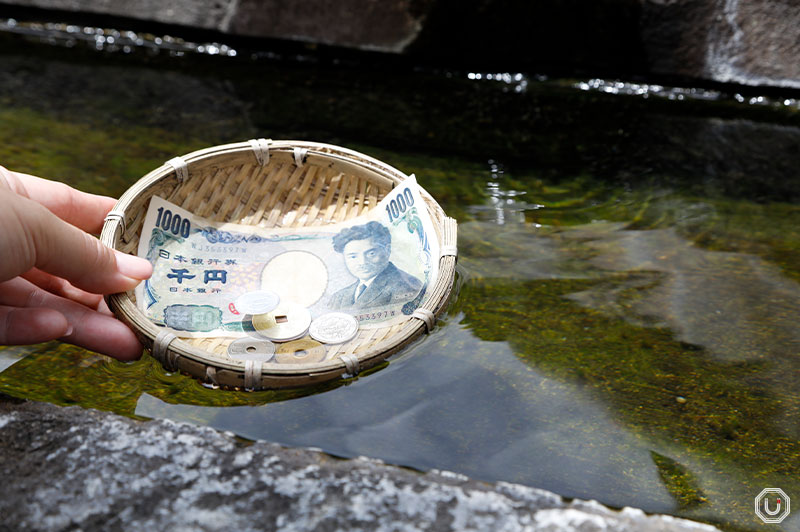
Zeniarai-Dokoro
At the Shirohebi Benzaiten Shrine, pay your respects with your purified Shirohebi tanesen and money. Use the two bows-two claps-one bow method described above, and wish for wealth, success, or a good love match.
After this, keep the Shirohebi tanesen in your wallet, and your purified money at home to avoid it getting dirty.
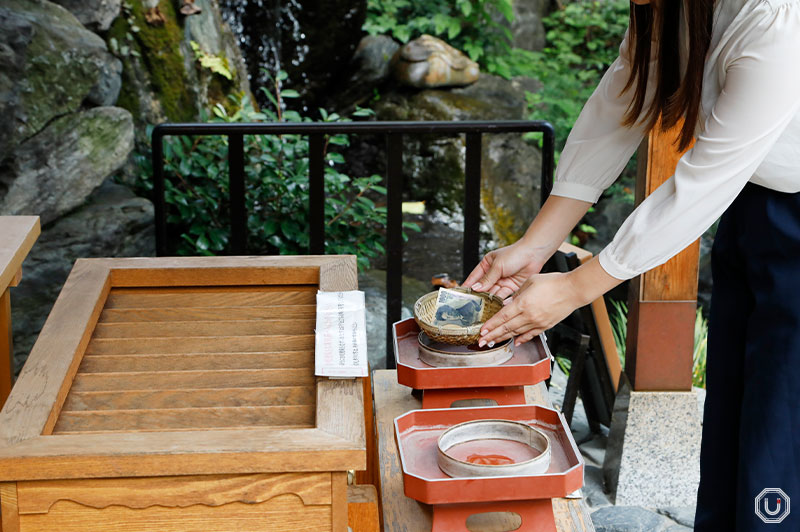
Shirohebi Benzaiten Shrine
Starting at the temizuya and ending at Shirohebi Benzaiten Shrine is the recommended route. It’s an enjoyable experience, likely to become a cherished memory.
During busy times like the New Year season, you might not be able to try the Zeni-Mawashi or the zeniaraijo, but don’t worry! Purified Shirohebi tanesen are available, so you can still receive its blessings.
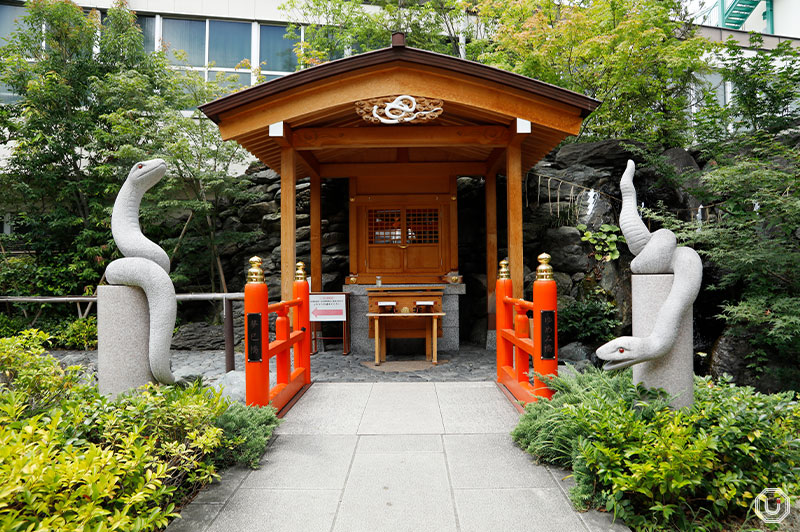
Lucky charms for financial success and distinctive goshuin featuring the white snake
Japanese shrines and temples often offer their own special goshuin (a special seal obtained as proof of pilgrimage). At Hebikubo Shrine, you can collect three types throughout the year.
All of them feature a seal of the white snake, making them particularly unique.
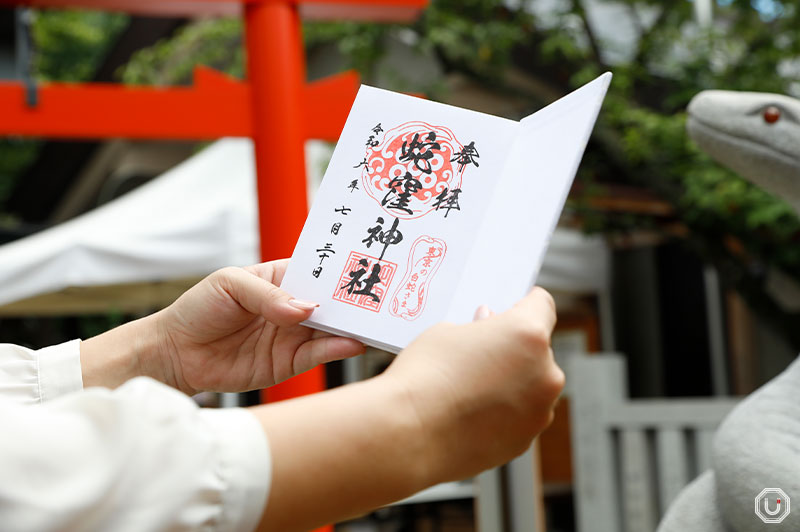
Goshuin 300 JPY
The goshuinchō (seal book) also has a special design where an illustration of a white snake appears depending on the angle of light.
With its sophisticated design, it feels like it could bring good luck just by owning it. It’s so stylish, it might even be worth displaying in your home.
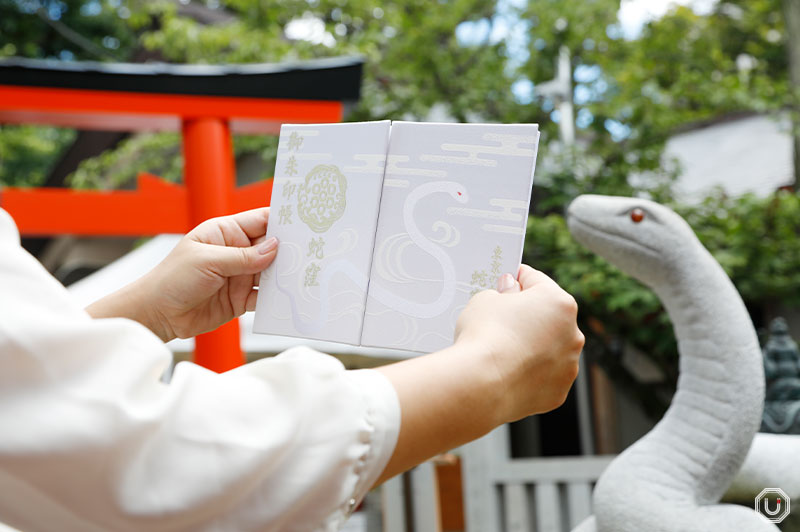
Goshuincho 1,500 JPY
Given the shrine’s connection to snakes, even the omamori (amulets available at Japanese shrines and temples and granting good luck or protection) have unique features.
The “Shirohebi Okimono” is an amulet shaped like an actual snake. It’s a decorative item perfect for home display, believed to bring blessings such as financial success.
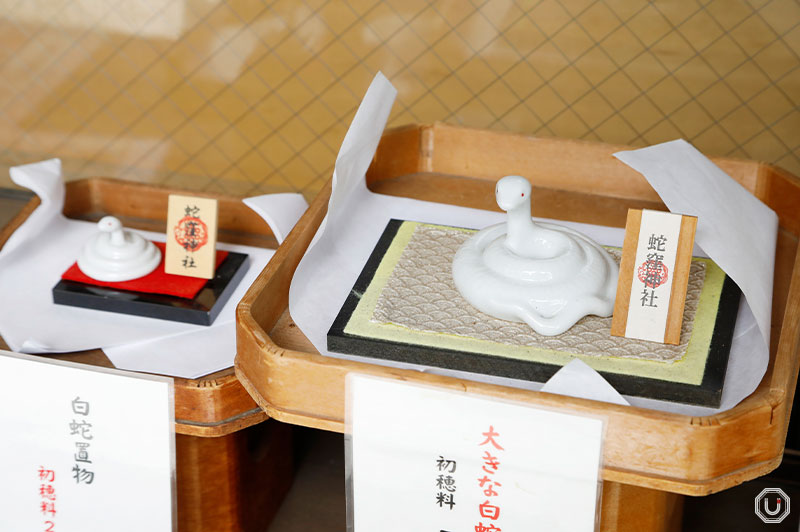
“白蛇置物,” Shirohebi Okimono 2,000 JPY (left); ”大きな白蛇置物,” large Shirohebi Okimono (right) 5,000 JPY
The white snake is considered so lucky that it’s said dreaming of one can lead to winning the lottery.
The ema (wooden votive plaques on which visitors write their wishes) at Hebikubo Shrine also feature a white snake motif. People with various wishes, not just those aiming for a big lottery win, inscribe them on the ema and dedicate them to the shrine by leaving them there.
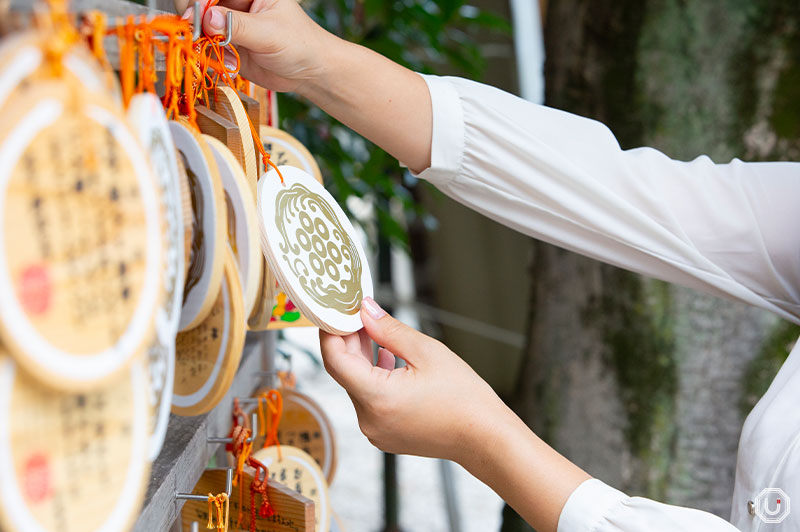
Shirohebi Ema (1,000 JPY)
Among the various omikuji (fortune slips available at Japanese shrines or temples), the most popular one is the “Ichiryū Manbai Mikuji.” It’s inspired by the idiom ichiryū manbai, meaning “one grain of rice will produce ten thousand,” and also evokes a common term for auspicious days on which important things are carried out.
This omikuji is shaped like a grain of rice, with a paper inside that reveals your fortune.
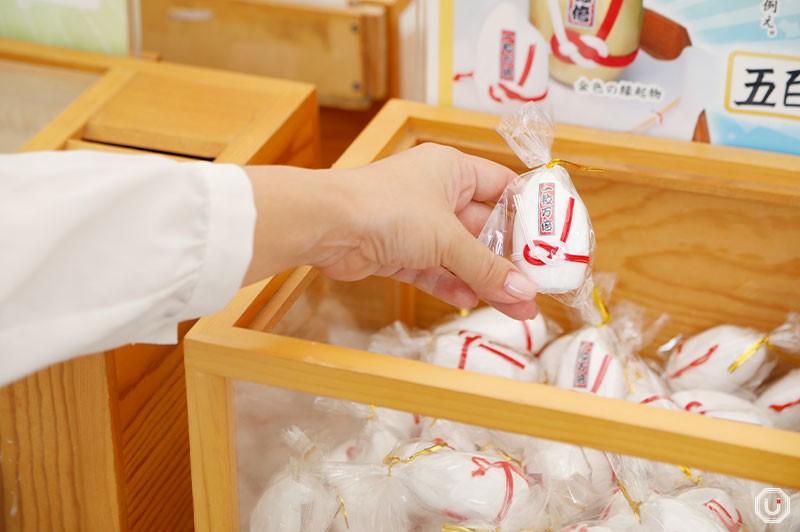
Ichiryu Manbai Mikuji 500 JPY
If your fortune slip has chō hōsaku (meaning “super bumper crop”) written on the back, you’ll receive a special gift!
Let the shrine office know, and you’ll be given the “Ichiryū Okubai” (meaning “one grain will produce a hundred million”), a gold-colored lucky charm with special blessings. What exactly is it? That’s a surprise you’ll have to discover when you receive it!
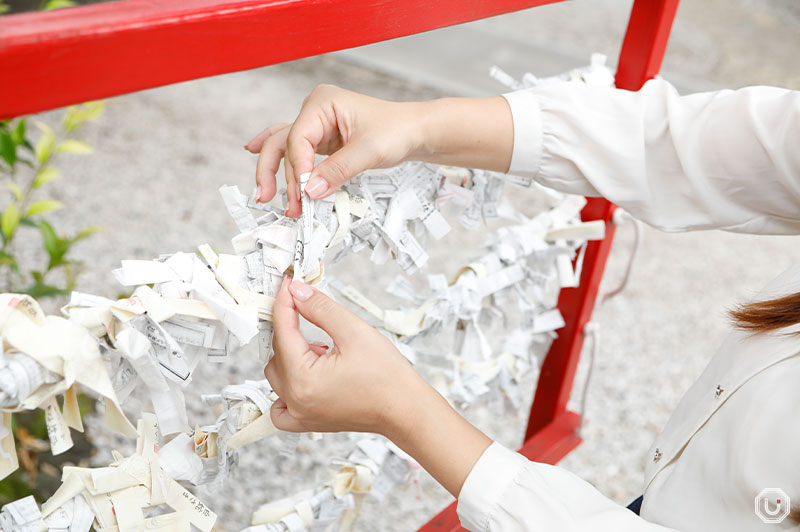
So much to see! What makes Hebikubo Shrine so special
Hebikubo Shrine has even more to offer.
The Hōmitsu Inari Shrine is a small shrine within the grounds, adorned with 111 lanterns. They were placed as an expression of gratitude after a successful fasting prayer for rain during a severe famine long ago.
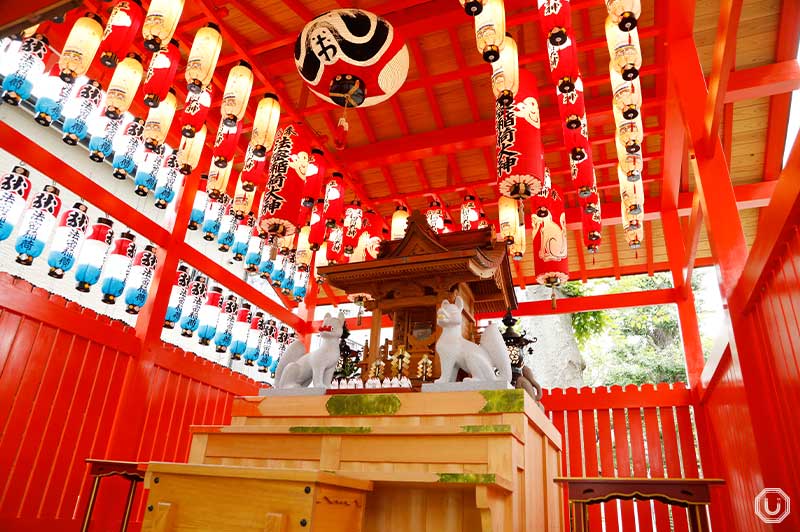
Homitsu Inari Shrine
The “Mangan Iwa” (meaning “wish-fulfilling rock”) offers a chance to test your luck. You throw special stones at the rock, and if they land in its hollow, your wish is said to come true.
Other points of interest include the “Negaikake Mizukake Hōju” (meaning “make-a-wish-and-pour-water jewel”), believed to grant blessings if you pour water over it while making your wish, and the “Omokaru Kitsune-Ishi.” This omokaru ishi (meaning “heavy-or-light stone”)—a fortune-telling stone believed to fulfill wishes if it feels light upon picking it up—looks like a curled-up kitsune (meaning “fox”) cub, a nod to the animal’s association with inari shrines.
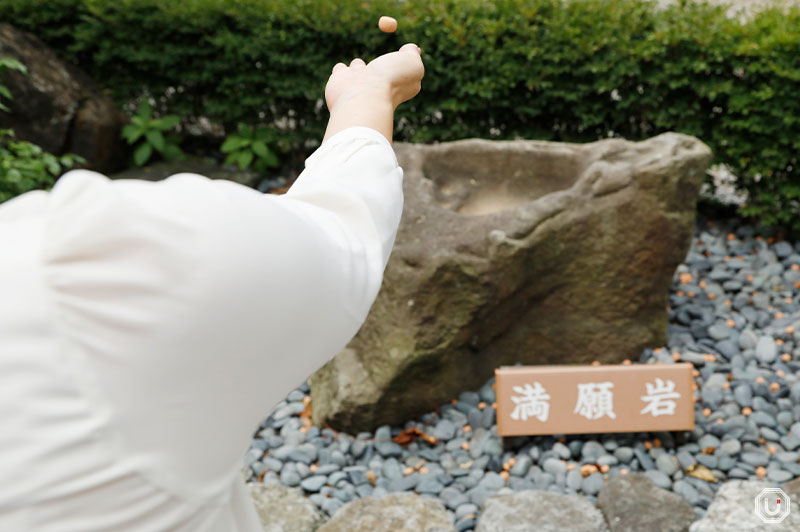
Stone-throwing 100 JPY for three stones
The “Guchi Tsubo” (literally “complaining pot”) is another unique feature, a big pot in which you can shout out your daily worries and gripes. Open the lid, yell as loud as you can, and you’ll feel much better!
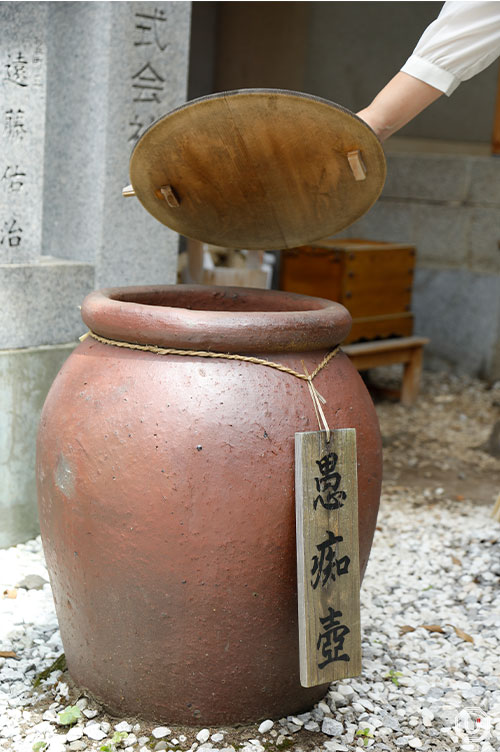
Guchi Tsubo
There are even occasional displays of live white snakes at Hebikubo Shrine.
These exhibitions are held irregularly, so if you happen to see one, consider yourself very lucky—it might just bring you even more blessings.
Hebikubo Shrine is a place to take your time and enjoy various experiences. It’s sure to be an unforgettable visit.
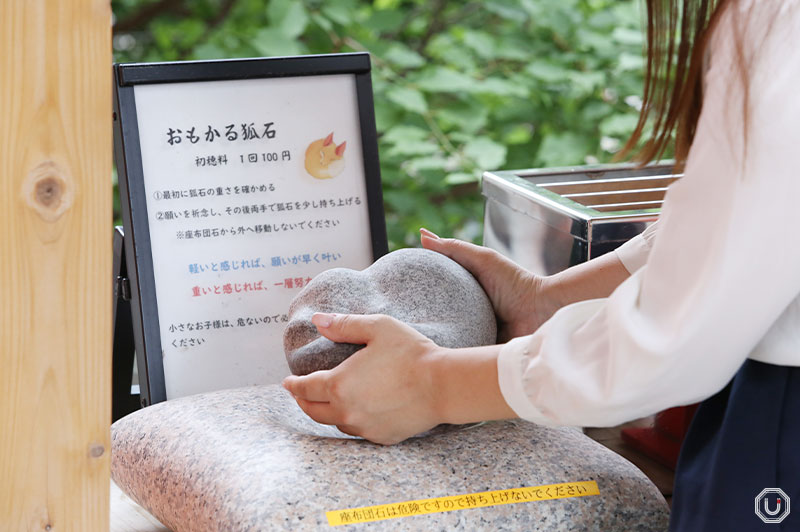
The Omokaru Kitsune-Ishi 100 JPY per turn
Shrine Information
| Name | 蛇窪神社 Hebikubo Shrine |
|---|---|
| Address | 4-4-12 Futaba, Shinagawa-ku, Tokyo
|
| Access |
Nakanobu Station 5-minute walk from Exit A3
Nakanobu Station 6-minute walk from Nakanobu Station Tokyu Gate
Nishi-Oi Station 8-minute walk from exit
|
| Phone number | 03-3782-1711 |
| Visiting Hours | 24 hours |
| Sacred Items | 9:00-17:00 |
| Goshuin | 9:00-17:00 |
| Omikuji | 9:00-17:00 |
| Admission fee | Free |
| Official website | https://hebikubo.jp/ |
| Other information |
|
※The information in this article is current as of August 2024.
